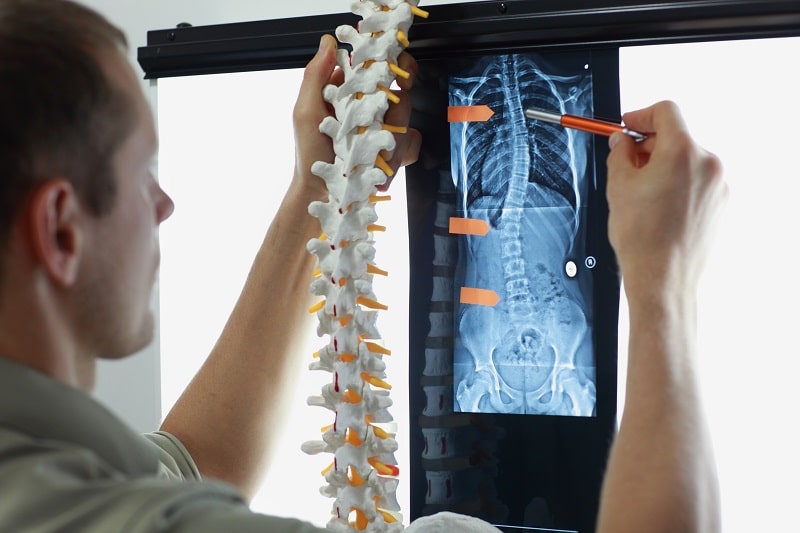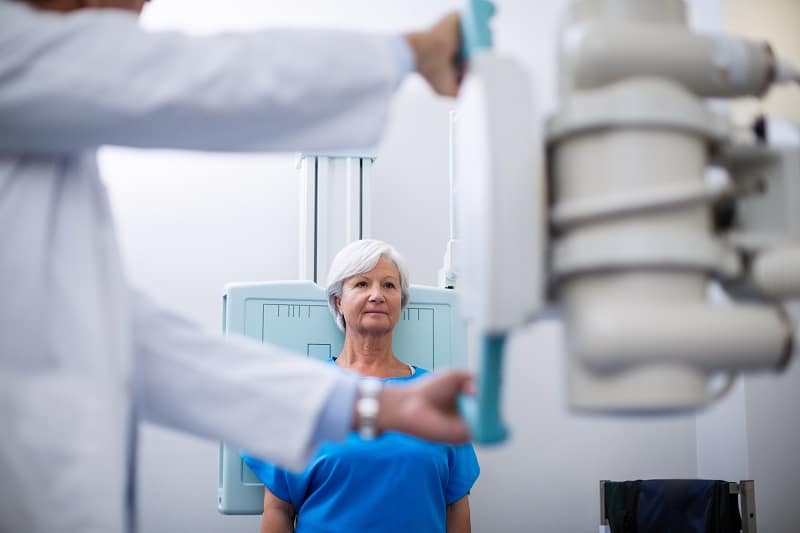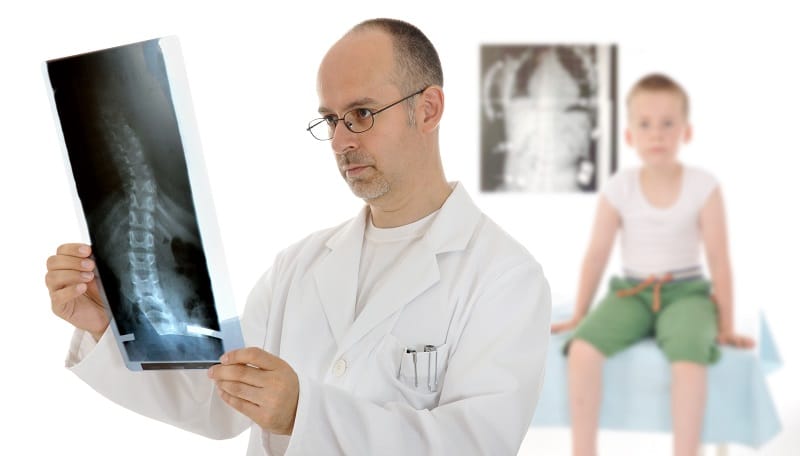How to Know Which Spine You Are at on Ct
The Scoliosis X-ray is the most mutual method of diagnosing and monitoring a patient'due south scoliosis. Once whatsoever underlying pathology or conditions are ruled out, X-rays tin can tel l us what we need to know most a patient's status. While many people notwithstanding have concerns regarding side effects of frequent Ten-rays, those concerns are unfounded. Typically, a scoliosis 10-ray should be taken from a certain distance; the automobile should exist 72 inches abroad from the patient's trunk. If the 10-ray motorcar is closer than 72 inches, what tin happen is the scoliosis is magnified, making the curve appear slightly larger. Secondarily, scoliosis 10-rays should include the unabridged spine, meaning from the neck to the pelvis; this is necessary for getting the nigh accurate images of the spine. Thirdly, the patient should be standing, with artillery relaxed, and no shoes on. Ultimately, the X-ray should be taking an prototype of the entire spine all at the same time. Although X-rays go along to be the most reliable, noninvasive, accessible, and cost-effective method for diagnosing and monitoring scoliosis, there are some common mistakes that can be made. A lot of times, machines aren't big enough to take the entire spine, so the images are taken sectionally. There would be 1 taken of the cervical spine (upper back), some other of the thoracic spine (eye back), and 1 taken of the lumbar spine (lower back). These images are then stitched together to make a single X-ray image out of the dissever images. That stitching procedure can create an error, which can be very damaging in terms of accuracy. While it might non seem important whether or not a patient getting a scoliosis X-ray wears shoes, I can clinch yous it is. The principal issue is that shoes can be worn improperly, throwing things off balance, and this can skew the results. Some other common issue that can change scoliosis X-ray results is the position the patient is in while the X-ray is being taken. Sometimes, Ten-rays are taken while a patient is leaning dorsum against the machine. This is not an appropriate position, equally it can modify the scoliosis. Patients with scoliosis often take rib problems where some are further back on one side and more forrad on the other. When a patient leans back, it creates a turn and rotation, and that can lead to a bad X-ray. I've seen scoliosis X-rays that are taken while the patient is lying down; this is horrible for scoliosis X-rays considering curves typically reduce when lying down, so Ten-rays taken from this position won't give accurate measurements. Another error tin occur if the patient'due south arms are not relaxed, or even worse, if they're purposely positioned symmetrically. This can occur when a patient'due south experiencing some blazon of pain. If the 10-ray technician changes the position to make the patient more comfy, this tin change the presentation of the pic. Typically, scoliosis X-rays should be taken while the patient is in a standing position and from a diverseness of angles. A lot of times, when y'all're trained to accept a scoliosis Ten-ray, you're trained to take the nigh tilted vertebra of the lowest part of the spine and compare it to the almost tilted vertebra as you go upward the spine. Comparing this tilt to a horizontal level is what gives you the Cobb bending: the well-nigh standard measurement for scoliosis. For example, if L4 is tilted xv degrees to the left and L1 is tilted xx degrees to the right, adding those will requite you a 35-degree Cobb angle. However, the most tilted vertebra is a niggling subjective. Let's say a patient'south nigh tilted vertebra is from L4 to T11 and the angle measurement is 50 degrees. If someone else looks and thinks that T9 is the most tilted vertebra and measures from L4 to T9 instead, they'll get a completely different measurement. In a scoliosis Ten-ray, there's an acceptable error rate of upward to 5 degrees from one md to some other. What that means is if ane doctor measures a 50-degree scoliosis and some other doc measures it at 45 degrees without discussing how the measurement was taken, the measurements are considered to exist the same because of that 5-degree error rate. Now, for a dr. that measures their ain X-rays and compares and counts the vertebra from the showtime visit to the next, there should only be a ii-degree mistake rate; this is because they're measuring the same movie with the same vertebra over and over again. In terms of getting the nigh accurate results from a scoliosis X-ray, it's advantageous to work with the same scoliosis specialist throughout the entire class of treatment. Non only is a Cobb bending measured from 10-rays, other critical information is gathered as well. Coronal residuum is another finding used to assist determine the all-time course of treatment; this measurement expresses how the pelvis is vertically aligned to the torso. If the films are taken correctly, the pelvis should be included. This allows the md to assess the Risser Sign. Risser is extremely important for adolescent cases of scoliosis because it helps decide the likelihood of progression due to growth. The Risser scale goes from 0 (full growth potential) to Risser v (full skeletal maturity). A consummate and comprehensive set of scoliosis films should also include a Lateral Cobb bending (10-ray taken from the side, non front end to back). This lateral Cobb picture show also gives lots of information regarding how to treat the patient. Variables such as sagittal rest, lumbar lordosis, thoracic kyphosis sacral inclination, and pelvic incidence all come into play. Remember, scoliosis is more than than only a curve in the spine; information technology'southward a 3-dimensional problem, so addressing the spine's sagittal component is a crucial aspect of handling. Scoliosis X-rays are taken to decide how the spine is either improving or progressing. Minimally, during growth, you want Ten-rays taken every six months and definitely no longer than a year autonomously. During treatment, scoliosis X-rays happen more than often because you're looking for improvement. If a patient'south going through treatment, X-rays might exist washed within a month of each other to make sure the spine is responding to handling. The last affair a doctor, or a patient, wants to do is go through a bunch of treatment, only to find out information technology didn't modify anything. Scoliosis Ten-ray frequency tin vary depending on whether a patient is in active handling or simply being observed. The danger of solely using observation is when Ten-rays are taken at fixed time frequencies of, let's say, every six months, a lot of things can change in those six months. For parents and caregivers of children with scoliosis, they shouldn't rely solely on Ten-rays for observation; they should exist instructed on how to check for other signs of progression in between scheduled X-rays such as checking posture and looking for rib and waist issues. This includes being particularly vigilant during signs of growth. This is because growth is the number one reason why scoliosis progresses in children, and unfortunately, it can happen quickly during rapid growth spurts. For example, permit'southward say you lot and your 12-yr-old daughter are told to come back in one yr. The twenty-four hours after you are told that, your daughter begins a major growth spurt and enters into an aggressive stage of her scoliosis progression. A tremendous amount of progression can happen over that yr that could have been prevented. While there are other signs of progression that tin can exist detected without Ten-ray, Ten-ray does remain the most sensitive. Some mild and moderate conditions don't show any postural signs, but an 10-ray can evidence a curvature every bit pocket-sized as 5 or 10 degrees. A lot of people have concerns most the potential negative effects of frequent X-rays on children, but those concerns are outdated and unfounded. There is a lot of information regarding low-dose Ten-rays and how the risk of whatever potential negative side effects is extremely low. In fact, lifetime cancer run a risk increases 0.002% for chest X-rays . New data is really showing that low-dose 10-rays tin can have a healing effect. In scoliosis treatment and monitoring, scoliosis Ten-rays are taken in intervals of 3 to 6 months. This allows for the body to recover and repair. Ultimately, I wouldn't worry most getting the minimal amount of X-rays to monitor your scoliosis. I would worry more about your scoliosis progressing because not enough Ten-rays are being taken to determine if handling is working or non. A scoliosis 10-ray remains the most definitive tool for determining the all-time treatment arroyo for the patient. The shape and nature of a patient's scoliosis is going to dictate how they are likely to answer to bourgeois handling methods such as exercise, therapy, chiropractic, and bracing. All these approaches are directly related to what we see on a patient'southward scoliosis 10-ray. Without a scoliosis X-ray, there is no roadmap for treatment. In addition to taking a standard ready of lateral bending scoliosis X-rays, in that location are other X-rays that can be used such as sagittal (side view) 10-rays used to wait at the sagittal contour. These types of 10-rays taken while angle to the left and then bending to the correct assist determine the patient's level of flexibility in the spine. The flexibility or rigidity of a patient'due south spine is of import because it tells the states how likely it is that a patient's going to be able to accomplish a reduction. The stiffer a patient's spine is on the lateral bending 10-rays , the less likely it is that their spine will respond and the more likely it is that the patient will exist in demand of a more therapeutic approach to improve flexibility. Scoliosis 10-rays tin can tell the states everything nosotros demand to know almost a patient's condition. We can measure the caste of their curvature, can encounter where along the spine the scoliosis is, and can decide how stiff or flexible a patient's spine is. These factors are essential in determining the best course of treatment for a patient and how likely it is that their scoliosis will respond to the chosen treatment approach. While 10-rays remain the gold standard for diagnosing, assessing, and monitoring scoliosis, they are all the same vulnerable to human error. Knowing these areas of vulnerability and how important the correct positioning is can help you lot abet for yourself, or a loved 1, to ensure the about accurate measurements are being taken. Without a scoliosis 10-ray, there'south no roadmap for a patient'southward treatment, which is why here at the Articulate Scoliosis Plant, nosotros employ specialized 'spot' X-rays to assess the spine 3-dimensionally. With an authentic assessment of what's happening with the entire spine provided by a scoliosis X-ray, our patients have the best possible chance of responding favorably to the chosen handling approach. "The author'due south views are his or her own and may not reflect the views of CLEAR Scoliosis Plant." How Should a Scoliosis X-Ray be Taken?

Common Scoliosis X-Ray Errors
Stitching Images
Wearing Shoes
Torso Positioning

How Scoliosis X-Ray Measurements are Taken
Why Scoliosis X-Rays are Taken

Ten-Ray Side-Effect Concerns
The idea of Ten-rays having a linear threshold, meaning every X-ray taken has a toxic effect on the torso that builds up with each successive X-ray has been proven to exist false.
There are two theoretical models of X-ray exposure to human being bodies.
Scoliosis X-Rays Decide Handling Arroyo

Lateral Bending 10-Rays
Conclusion
Additional Resources:
Source: https://clear-institute.org/blog/scoliosis-x-rays/
0 Response to "How to Know Which Spine You Are at on Ct"
Post a Comment